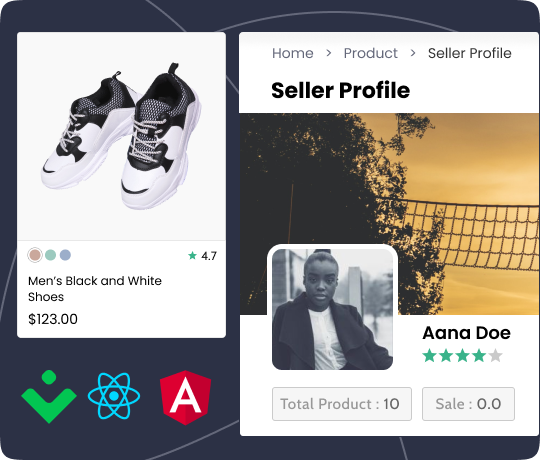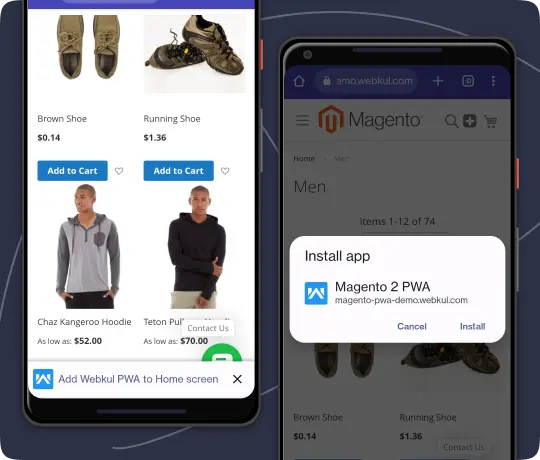Magento 2 Headless Development
With Magento 2 Headless Development, you can create fast, flexible, and customized e-commerce storefronts. This approach offers the freedom to build next-generation digital commerce experiences and deliver exceptional shopping experiences across various channels and platforms.
Features of Magento 2 Headless Development

Personalization
Headless development enables personalized shopping experiences for diverse customer segments. By leveraging multiple storefronts, you can tailor content and offers for different regions, enhancing relevance and engagement for local buyers.

Faster Websites
Headless e-commerce optimizes page load times by allowing developers to select the most suitable technology stack for both front-end and back-end systems. This results in a faster and more responsive user experience.

Decoupled Architecture
The separation of front-end and back-end systems in headless commerce allows teams to work independently and in parallel. This decoupling promotes faster time-to-market and enhances development efficiency.
Magento 2 Headless Storefront
In a Magento 2 headless storefront, the front end operates using JavaScript frameworks such as React, Vue.js, or Angular. It interacts with the back-end API to retrieve data while excluding the back-end functionalities provided by Magento 2. This separation offers greater flexibility, improved speed, and an enhanced user experience. Development involves deploying the front end and back end separately, leading to quicker and more efficient development cycles.


Magento 2 Headless Theme
A headless theme features a custom front-end design built with JavaScript frameworks like React or Vue.js. It integrates with the Magento 2 back-end API to fetch and display data, providing a unique and tailored user experience.
Magento 2 Headless Compatible Extension
Magento supports numerous modules for adding new features and integrations. Many third-party extensions can be adapted to support headless commerce, allowing you to extend your store’s functionality in a headless environment.


Magento 2 Headless PWA
Progressive Web Applications (PWAs) use modern web technologies including HTML, CSS, and JavaScript to deliver fast and engaging browsing experiences. A Magento 2 Headless PWA is a lightweight web app that offers the advantages of a mobile or desktop app with reduced development time and resources. PWAs are updated automatically via a service worker, eliminating the need for users to manually install or update the app.
Magento 2 Headless Mobile App
A Magento 2 headless mobile app refers to a mobile app that uses a headless approach. The front end uses a native mobile apps framework. Such as React Native or Flutter, and communicates with the Magento 2 back-end API to retrieve data. This design allows for a seamless UX and improved speed, as the app can get the data in real-time. It also provides for better customizability and integration with the online store. At the same time, it maintains separate and distinct Android and iOS mobile apps.

Magento 2 Headless Development Lifecycle
Gather Information and Analyze Data
Software Planning and Wireframing
Software Prototype and Designing
Software Development and Execution
Software Testing and Feedback
Software Install and Support
Magento 2 Headless Development Support Many Frameworks
Our Magento 2 Headless Development is not limited to a single platform. Code Legion offers headless commerce services leveraging the latest and most widely-used technologies:

React.js
Vue.js
Gatsby.js
Next.js
Vue Storefront

Hyva Themes

React.js
Vue.js
Gatsby.js
Next.js
Vue Storefront

Hyva Themes
Why Code Legion?
- Code Legion stands out for its deep expertise and commitment to delivering exceptional e-commerce solutions. Our partnership underscores our capability to handle complex Magento projects with precision and innovation.
- Our portfolio includes building marketplaces, integrating payment gateways, and implementing shipping methods, showcasing our versatility and expertise.
- At Code Legion, our blend of experience, recognition, and technical excellence makes us a trusted partner for businesses looking to excel in the e-commerce space.
FAQS
In Magento 2 headless development, Magento serves as the back-end system, managing core e-commerce functions such as commerce, checkout, and order processing. The front-end, however, is built using different technologies or custom designs, providing flexibility in how the storefront is presented and interacted with.
Headless commerce operates by separating the front-end user interface (UI) from the back-end system. Typically, the front-end is constructed using JavaScript frameworks like React or Vue.js. This front-end connects to the back-end Magento system via APIs to retrieve data—such as product information—or to perform actions like adding items to the cart or processing payments. The back-end, which is the headless commerce platform (Magento in this case), handles all commerce-related tasks including product management, order processing, customer management, and more.
The cost of developing a headless commerce solution can vary based on several factors, such as the complexity of the project, the size of the development team, and the resources required. Generally, headless commerce projects can be more costly than traditional e-commerce setups due to the need for both front-end and back-end development, as well as the integration of APIs. This increased complexity can result in higher development costs.
The suitability of headless commerce depends on your business goals and technical capabilities. Headless commerce offers significant flexibility and improved user experience but requires expertise in API integrations and front-end development. If your goal is a highly customizable, adaptable solution with the ability to make rapid changes to the front end without affecting the back end, headless commerce could be a good fit. However, if you prefer a more integrated and traditional e-commerce solution, or if you lack the necessary technical resources, a standard commerce platform might be more appropriate.
While it’s challenging to predict the future with certainty, headless commerce is gaining traction and popularity. Its flexibility and enhanced user experience capabilities position it as a strong option for modern e-commerce. As e-commerce continues to evolve, headless commerce offers the advantage of quick and seamless storefront changes without disrupting back-end operations. This adaptability and customization potential suggest that headless commerce will likely remain a significant player in the future of digital commerce.